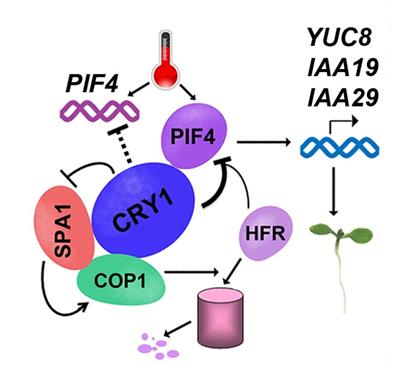
It has been known for decades that blue light and temperature are two key environmental signals that profoundly affect crop growth and yield, however, how these two abiotic factors integrate remains largely unknown.
A research group led by Dr. LIU Hongtao at the Institute of Plant Physiology and Ecology, Shanghai Institutes for Biological Sciences use hypocotyl elongation as a system to address the question of how blue light regulates plant development in coordination with temperature in the model plant Arabidopsis thaliana. They found that cryptochrome regulates high temperature mediated hypocotyl elongation in response to blue light.
Cryptochromes are photolyase-like blue-light receptors first discovered in Arabidopsis and later found in all major evolutionary lineages. Arabidopsis cryptochrome 1 (CRY1) mediates primarily blue-light inhibition of hypocotyl elongation. By contrast, high temperature has been known to exert an opposite effect on hypocotyl elongtion. Increased temperature leads to longer hypocotyl.
Dr. LIU Hongtao and her colleagues demonstrate that blue light represses high temperature-induced hypocotyl elongation through CRY1. PIF4 (PHYTOCHROME INTERACTING FACTOR4) encodes a bHLH transcription factor that promotes hypocotyl elongation by inducing auxin biosynthesis. Intriguingly, CRY1 physically interacts with PIF4 in a blue light dependent manner to repress the transcription activity of PIF4. As a result, CRY1 represses auxin biosynthesis in response to elevated temperature, thereby inhibiting hypocotyl elongation. PIF4 is the first blue light dependent CRY1 interacting transcription factor, and it appears to be the molecular basis for cross talk between blue light, red light and ambient temperature.
This work entitled “Cryptochrome 1 interacts with PIF4 to regulate high temperature mediated hypocotyl elongation in response to blue light” has been published online in PNAS on December 22.
The research was funded by National Natural Science Foundation of China and Chinese Academy of Sciences.
CONTACT:
LIU Hongtao, Ph.D., Principal Investigator
National Key Laboratory of Plant Molecular Genetics, CAS Center for Excellence in Molecular Plant Sciences, Institute of Plant Physiology and Ecology, Shanghai Institutes for Biological Sciences, Chinese Academy of Sciences,
Shanghai 200032, China
Tel: 86-21-5494291
Fax: 86-21-54924015
E-mail: htliu@sibs.ac.cn

A hypothetical model depicting CRY1 mediated blue-light regulation of PIF4. The model hypothesizes that in response to blue light, CRY1 interacts with PIF4 to repress the activity of PIF4 promoting transcription of the target genes, and CRY1 can also repress PIF4 through inhibiting COP1 mediated degradation of HFR1. (Image by MA Dingbang)

86-10-68597521 (day)
86-10-68597289 (night)

52 Sanlihe Rd., Xicheng District,
Beijing, China (100864)

